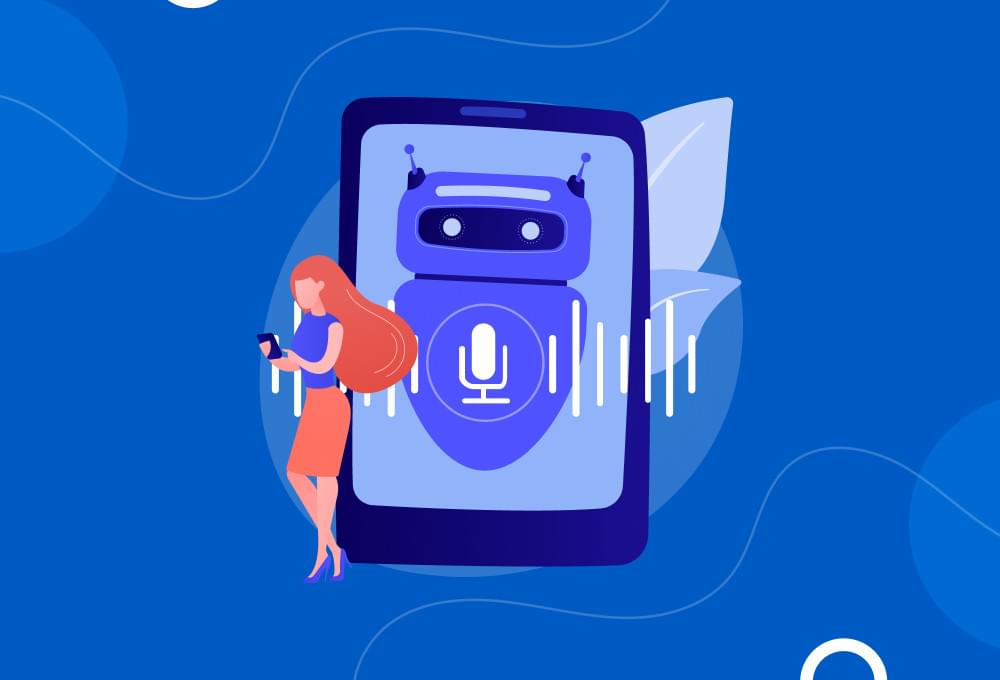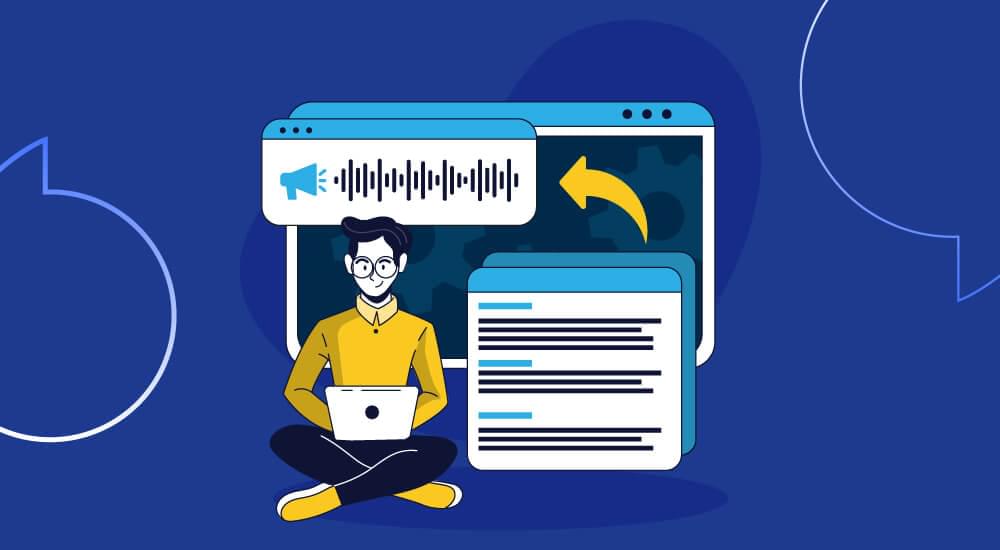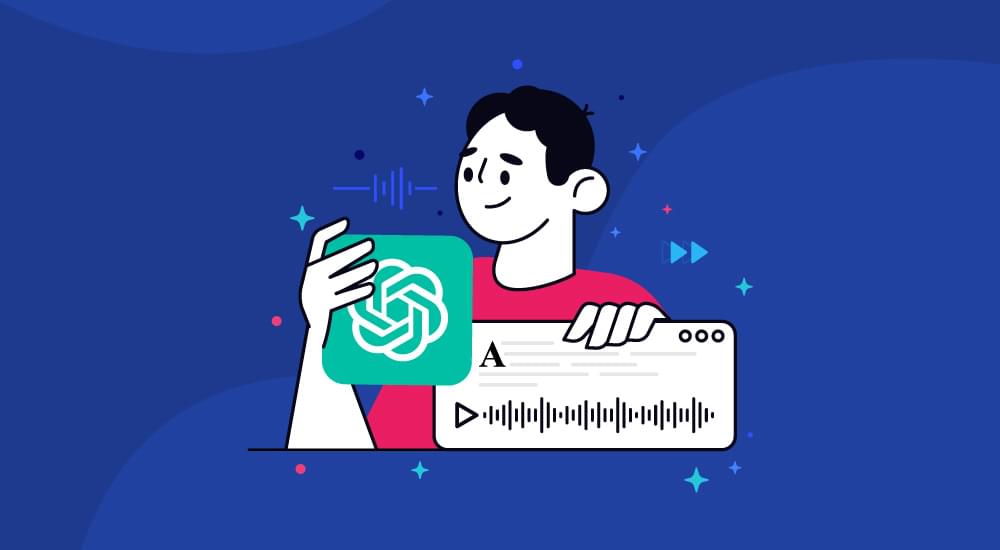text to speech tutorials
AI's Role in Crafting Human-like TTS Voices
AI voice technology, also called natural speech synthesis or text-to-speech, is a domain of artificial intelligence (AI) that specializes in creating human-like speech using sophisticated techniques. By combining advanced algorithms and machine learning, AI voices can comprehend and transform written text into spoken words, presenting a groundbreaking means for computers and other electronic devices to engage with users through speech.
While computer-generated voices initially had limited naturalness and a lot of complexity, AI TTS evolution has undergone rapid advancements within the past decade. These advancements have significantly enhanced the technology’s capacity to recognize and replicate the nuances of human speech, capturing subtleties that have led to incredibly realistic and expressive AI-generated voices.
In this blog, we will discuss AI voice technology, exploring AI TTS evolution, the underlying mechanisms, real-world applications, and the remarkable developments in delivering more human-like and deep learning voices.
The Defining Characteristics of Human-Like TTS Voices
The Role of TTS Quality
A fundamental aspect of natural speech synthesis revolves around the quality of Text-to-Speech (TTS) technology. TTS serves as the foundation for creating AI voices that closely resemble human speech. While modern TTS has made considerable advancements in blurring the distinction between human and machine voices, certain challenges are still there. While brief TTS audio snippets may sometimes be indistinguishable from human speech, maintaining realistic intonation, emotion, and speech speed across various contexts remains an ongoing challenge.
The Significance of Interaction Delay
The time delay between user input and AI response, known as latency, plays a pivotal role in building immersive interactions. Latency encompasses Automatic Speech Recognition (ASR), Language Model (LM), TTS computation, and network delay. Extended latency can make interactions awkward, just like talking to someone who responds after an uncomfortable pause. Reducing latency is an important objective in creating deep learning voices.
The Intelligence Aspect
Ultimately, the intelligence of AI takes center stage in Human-Like AI (HAI) endeavors. The primary goal is effective task completion, and the level of competence demonstrated by AI TTS evolution in this regard significantly influences user satisfaction. An AI agent that shows the capability to perform tasks competently holds value, even if its speech quality mirrors that of a fictional droid.
Building Trust with Authentic Voices
Natural speech synthesis is a fundamental step in establishing user trust. A voice that comes across as credible, genuine, and relatable to users plays an important role in bridging the gap between humans and AI.
Reducing Interaction Delay
Addressing concerns related to latency needs innovative solutions. The introduction of dual-stream TTS, which synchronizes voice generation with text processing, represents a significant advancement in minimizing latency and enabling smoother interactions.
Conversation Experiences
Recognizing the diverse applications of TTS and deep learning voices, customizing conversation is a strategic approach. Adapting AI interactions to specific contexts empowers AI to gain a comprehensive understanding of various scenarios, thereby providing pertinent responses and expanding its service capabilities.
How AI Generates Human-Like TTS Voices?

Natural speech synthesis involves several advanced techniques, but they can be understood through three primary approaches:
Machine Learning Algorithms
Most artificial intelligence systems are based on machine learning algorithms that allow machines to learn from data and enhance their performance with time. Supervised learning is a common method for training AI voice models using extensive datasets of human speech. These datasets serve as a valuable source of linguistic patterns, phonetic structures, and speech dynamics.
Through supervised learning and neural TTS, the AI model becomes an expert in recognizing patterns and connections between written inputs and the corresponding spoken outputs. It learns from numerous instances of human speech and fine-tunes its settings to make its speech closely resemble that of a real human. As the model processes more data, it refines its grasp of phonetics, intonations, and other speech characteristics, resulting in progressively expressive and natural speech synthesis.
Natural Language Processing
Natural Language Processing (NLP) is a significant component of AI voice technology that enables machines to understand and interpret human language. NLP techniques allow AI to function like a language detective, dissecting written words and sentences to extract essential information, such as grammar, meaning, and emotions. NLP empowers AI voices to understand and articulate difficult sentences, even when words have multiple meanings or sound identical.
It’s like having a language expert to ensure that the AI voice sounds natural and coherent, regardless of the language’s complexity. NLP connects written text with spoken speech, keeping AI voices remarkably human-like, even when with challenging language nuances.
Speech Synthesis Techniques
Natural speech synthesis techniques are the foundation of AI voices, allowing machines to convert processed text into comprehensible and expressive speech. Various methods are used to achieve this, such as assembling recorded speech fragments to create sentences (concatenative synthesis) or employing mathematical models for speech generation (parametric synthesis), offering more customization.
In recent years, a groundbreaking technique known as neural TTS (Text-to-Speech) has emerged. It utilizes deep learning models, like neural networks, to produce speech from text. This approach has increased the level of naturalness and expressiveness of AI voices, capturing the subtle nuances that render human speech distinctive, including rhythm and tone. With neural TTS, AI voices now exhibit such lifelike qualities that distinguishing them from human voices can be difficult. This represents a significant stride toward making AI voices more human-like and engaging.
Related: Everything to Answer What is TTS (Text to Speech) Software
A Brief Evolution of TTS Voices

The intriguing fusion of voice and technology has been a source of fascination for a long time, from the early days of the telephone to the development of radios and walkie-talkies. However, in the 21st century, the soundscape has undergone a profound transformation, moving beyond the mere transmission of voice to encompass its recreation, modification, and even replication. This transformation owes its momentum to the integration of artificial intelligence into voice technology.
The application of AI voices isn’t merely an experiment in technological prowess it mirrors the growing demand for diverse, scalable, and highly functional vocal applications. With the proliferation of digital platforms and the evolving ways in which content is consumed, having AI-powered voices is not just an asset but a necessity.
From Text to Speech
The initial application of AI in voice technology was text-to-speech (TTS) software. The goal was simple: to convert written text into audible, human-like speech. TTS first found applications in assistive technology, particularly for the visually impaired, to transform written content into a format suitable for their needs.
Synthetic Voices and Deep Learning
With the refinement of algorithms and the advent of deep learning, the quality of synthetic voices witnessed significant enhancements. These voices ceased to sound overly rigid, awkward, and robotic. With AI TTS evolution, solutions use deep learning algorithms to capture the subtleties, tones, and intonations of human speech, rendering the output almost indistinguishable from real human speech.
Languages and Dialects
One noteworthy advantage of AI TTS evolution is its adaptability to various languages and dialects. While early TTS models were predominantly focused on English, modern AI can generate speech in multiple languages, often with specific regional accents. This adaptability is immensely valuable for global brands or content platforms catering to a diverse audience.
Interactivity and Responsiveness
AI TTS evolution has created voice systems designed not only to speak but also to listen and respond. Virtual assistants like Amazon’s Alexa or Apple’s Siri exemplify the remarkable progress in interactive AI voice technology. They can comprehend commands, provide responses to inquiries, and even adapt to the speech patterns and preferences of individual users over time.
Why Choose AI TTS Voices?
- Efficiency in Cost and Time: Instead of hiring human voice actors, those creating content can utilize voiceover tools for speedy and cost-effective outcomes.
- Versatility: AI tools provide access to a variety of voices in different languages, enabling content adaptation for a global audience.
- Consistency: AI-generated voices deliver uniform audio output, making them well-suited for e-learning modules and explanatory videos.
- Innovation: Rapid AI TTS evolution facilitates voice cloning, allowing individuals to employ their own voices in various applications, even when they are not physically present.
Real-Time Applications of AI Deep Learning Voices
The growing research and development in neural TTS and natural speech synthesis go beyond post-production or pre-recorded content. Advancements in machine learning have made real-time voice translation and modification possible, offering significant implications for various industries, including customer service, international conferencing, and entertainment. This enhances the efficiency and speed of content production.
TTS (Text-to-Speech) technology can bring about improvements and enhancements in different workflows and experiences across a range of industries:
- Accessibility: AI-powered voice technology aids individuals with disabilities by providing spoken content in a format they can easily comprehend.
- B2B and B2C Business: AI natural speech synthesis streamlines communication and offers versatile solutions for businesses, improving interactions with both other companies and end consumers.
- Education: TTS can make educational content more accessible and engaging, catering to diverse learning needs. The global E-Learning market, previously valued at $107 billion in 2015, is projected to soar to $325 billion by 2025, signifying substantial anticipated growth.
- Healthcare: In healthcare, AI voices can assist with patient interactions, ensuring that important information is conveyed clearly and accurately.
- Entertainment: AI voices can be used for dubbing, character voices, and other aspects of the entertainment industry.
- Marketing: AI-generated voices can be employed by online content creators in advertising to generate persuasive and engaging content and maximize the subscriber base.
- Translations: AI voices can be a valuable tool for translating content into different languages or helping individuals learn a new language.
- GPS Navigation Systems: AI voices provide directions and information for GPS navigation, making travel more convenient.
- Virtual Assistants: Virtual assistants like Siri and Alexa use AI voice technology to understand and respond to user commands.
- Customer Services: AI-powered voices enhance customer service by providing quick and efficient responses to inquiries and concerns.
Popular Examples of AI Voices
In an era of diverse content platforms, the need for realistic, efficient, and versatile voiceovers has surged. Around 30% of American consumers express willingness to subscribe to a monthly fee for access to a voice assistant offering such capabilities. Additionally, approximately 100 million consumers utilize voice commands to interact with assistants integrated into their mobile phones (39%), smartphone apps (25%), and connected devices such as speakers (27%). Smart Companies are turning to various AI tools to meet their voice requirements.
Here are some prominent examples of AI voice tools that cater to different needs:
- Text-to-Speech Generators: A leading name in AI text-to-speech generators, WebsiteVoice is known for its natural-sounding voices and multilingual capabilities. It smoothly converts written text into lifelike speech in over 38 languages, serving purposes from education to entertainment.
- TikTok & Social Media Platforms: Platforms like TikTok feature text-to-speech functionality and voice modulation filters. Social media influencers often rely on tools like Speechify, Resemble.ai, and Play.ht for their human-like voiceovers. Enhancing their content’s appeal and engagement. Additionally, they strategically leverage techniques like buying TikTok likes to boost visibility and reach on the platform.
- YouTubers: Content creators on YouTube often turn to platforms like Speechify, LOVO.ai, Murf.ai, and Play.ht for their diverse voice options in multiple languages.
- Microsoft’s Cortana: Microsoft’s digital assistant, Cortana, boasts human-like speech patterns, a result of extensive research in speech synthesis and machine learning.
- Apple’s Siri: Siri, one of the pioneering voice AI systems, achieves its natural sound through advanced speech synthesis algorithms.
- Google’s Text-to-Speech: Google’s solution utilizes its robust AI infrastructure and offers various speech styles, serving mobile devices and web applications.
- Amazon’s Alexa: Beyond being a virtual assistant, Amazon’s Alexa features voice technology powered by advanced machine learning frameworks, making waves in the smart home sector.
- E-Learning Platforms: The educational sector has readily embraced AI voices with tools like Natural Reader and iSpeech. These tools convert written materials into audio formats, catering to auditory learners and individuals with visual impairments.
- Chatbots and Customer Service: Brands are increasingly adopting AI-powered platforms for their chatbots and virtual customer service agents. These agents provide round-the-clock support with a human-like and empathetic voice.
It’s a Wrap!
The improvements in AI Text-to-Speech (TTS) quality over the last decade have been remarkable, and this trend is expected to continue. TTS voices are continually evolving worldwide, with new languages added each month. The next generation of TTS is likely to exhibit fuller, smoother vocal transitions and a better understanding of content. Furthermore, you can anticipate the inclusion of even more languages.
With these advancements, it’s foreseeable that AI text-to-speech generators will become increasingly common and perhaps even predominant as the preferred choice for voiceovers in e-learning and corporate multimedia localization in the coming decade.









